
- •Contents
- •Course Overview
- •Course Agenda
- •Document Conventions
- •Additional Information
- •Chapter 1: Course Introduction
- •Chapter 2: Junos Operating System Fundamentals
- •The Junos OS
- •Traffic Processing
- •Overview of Junos Devices
- •Chapter 3: User Interface Options
- •User Interface Options
- •The Junos CLI: CLI Basics
- •The Junos CLI: Operational Mode
- •The Junos CLI: Configuration Mode
- •Lab 1: The Junos CLI
- •Chapter 4: Initial Configuration
- •Factory-Default Configuration
- •Initial Configuration
- •Interface Configuration
- •Lab 2: Initial System Configuration
- •Chapter 5: Secondary System Configuration
- •User Configuration and Authentication
- •System Logging and Tracing
- •Network Time Protocol
- •Archiving Configurations
- •SNMP
- •Lab 3: Secondary System Configuration
- •Monitoring Platform and Interface Operation
- •Network Utilities
- •Maintaining the Junos OS
- •Password Recovery
- •Lab 4: Operational Monitoring and Maintenance
- •Appendix A: Interface Configuration Examples
- •Review of the Interface Configuration Hierarchy
- •Interface Configuration Examples
- •Using Configuration Groups
- •Appendix B: The J-Web Interface
- •Configuration
- •Lab 5 (Optional): The J-Web Interface
- •Appendix C: Acronym List
- •Appendix D: Answer Key
- •Chapter 1: Course Introduction
- •Chapter 2: Junos Operating System Fundamentals
- •Chapter 3: User Interface Options
- •Chapter 4: Initial Configuration
- •Chapter 5: Secondary System Configuration
- •Chapter 6: Operational Monitoring and Maintenance

Introduction to the Junos Operating System
Chapter 2: Junos Operating System Fundamentals
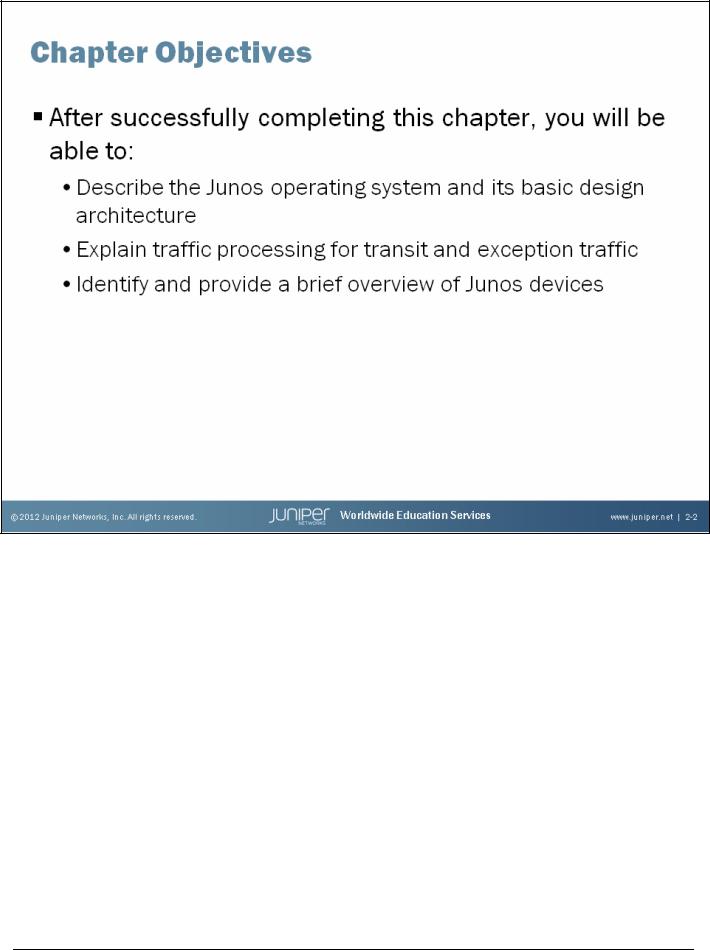
Introduction to the Junos Operating System
This Chapter Discusses:
•The Junos operating system and its basic design architecture;
•Traffic processing for transit and exception traffic; and
•Junos devices.
Chapter 2–2 • Junos Operating System Fundamentals |
www.juniper.net |

Introduction to the Junos Operating System
The Junos OS
The slide lists the topics we cover in this chapter. We discuss the highlighted topic first.
www.juniper.net |
Junos Operating System Fundamentals • Chapter 2–3 |
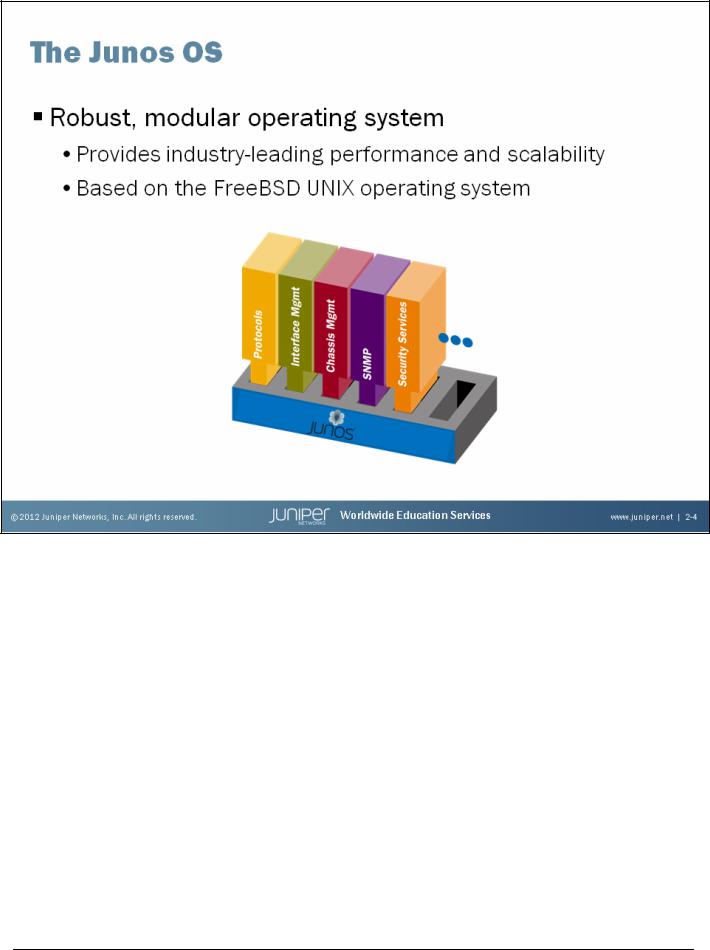
Introduction to the Junos Operating System
Robust, Modular, and Scalable
Junos OS functionality is compartmentalized into multiple software processes. Each process handles a portion of the device’s functionality. Each process runs in its own protected memory space, ensuring that one process cannot directly interfere with another. When a single process fails, the entire system does not necessarily fail. This modularity also ensures that new features can be added with less likelihood of breaking current functionality.
The Junos OS is the trusted, secure network operating system powering the high-performance network infrastructure offered by Juniper Networks. The Junos kernel is based on the FreeBSD UNIX operating system, which is an open-source software system.
Chapter 2–4 • Junos Operating System Fundamentals |
www.juniper.net |

Introduction to the Junos Operating System
Although the source code base is the same for all platforms running the Junos OS, the images are platform specific and implement some features and services differently. We make a strict effort, however, to ensure features are implemented in a consistent manner when possible.
Single Software Source Code Base
All platforms running the Junos OS use the same source code base within their platform-specific images. This design ensures that core features work in a consistent manner across all platforms running the Junos OS. Because many features and services are configured and managed the same way, the setup tasks and ongoing maintenance and operation within your network are simplified.
Tip: This point in the chapter might be a great time to ask the students if they can think of any advantages of having a single software train and a consistent way of implementing common features across all network devices.
www.juniper.net |
Junos Operating System Fundamentals • Chapter 2–5 |
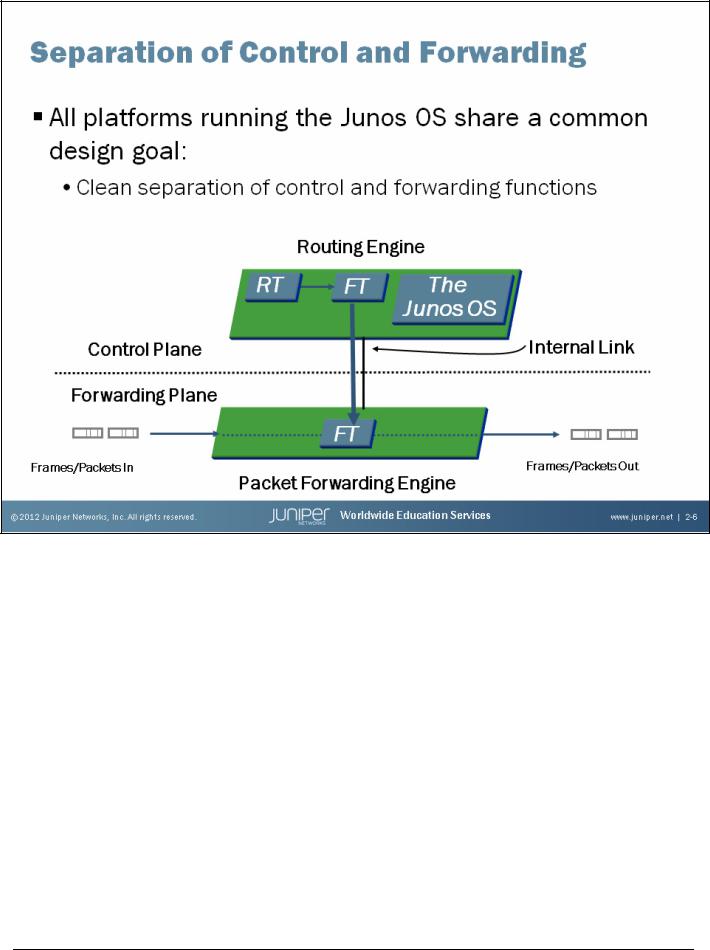
Introduction to the Junos Operating System
Separate Control and Forwarding Planes
Another aspect of Junos modularity is the separation of the control plane and the forwarding or data plane. The processes that control routing and switching protocols are cleanly separated from the processes that forward frames, packets, or both through the device running the Junos OS. This design allows you to tune each process for maximum performance and reliability. The separation of the control and forwarding planes is one of the key reasons why the Junos OS can support many different platforms from a common code base.
The slide illustrates a basic view of the Junos architecture and highlights the control and forwarding planes. The control plane, shown above the dashed line on the slide, runs on the Routing Engine (RE). The RE is the brain of the platform; it is responsible for performing protocol updates and system management. The RE runs various protocol and management software processes that reside inside a protected memory environment. The RE is based on an X86 or PowerPC architecture, depending on the specific platform running the Junos OS. The RE maintains the routing tables, bridging table, and primary forwarding table and connects to the Packet Forwarding Engine (PFE) through an internal link. Although all Junos devices share this common design goal, the actual components that make up the control and forwarding planes vary between the different Junos devices. For additional details about a specific Junos device, see the technical publications at http://www.juniper.net/techpubs/.
Continued on the next page.
Chapter 2–6 • Junos Operating System Fundamentals |
www.juniper.net |

We cover GRES and NSR in more detail in the Junos Intermediate Routing (JIR) course.
Introduction to the Junos Operating System
Separate Control and Forwarding Planes (contd.)
The PFE, shown below the dashed line on the slide on the previous page, usually runs on separate hardware and is responsible for forwarding transit traffic through the device. In many platforms running the Junos OS, the PFE uses application-specific integrated circuits (ASICs) for increased performance. Because this architecture separates control operations—such as protocol updates and system management—from forwarding operations, platforms running the Junos OS can deliver superior performance and highly reliable deterministic operation.
The PFE receives the forwarding table (FT) from the RE by means of an internal link. FT updates are a high priority for the Junos OS kernel and are performed incrementally.
Because the RE provides the intelligence side of the equation, the PFE can simply perform as it is instructed—that is, it forwards frames, packets, or both with a high degree of stability and deterministic performance. This architectural design also makes possible the incorporation of high availability features like graceful Routing Engine switchover (GRES), nonstop active routing (NSR), and unified in-service software upgrades (ISSUs).
www.juniper.net |
Junos Operating System Fundamentals • Chapter 2–7 |
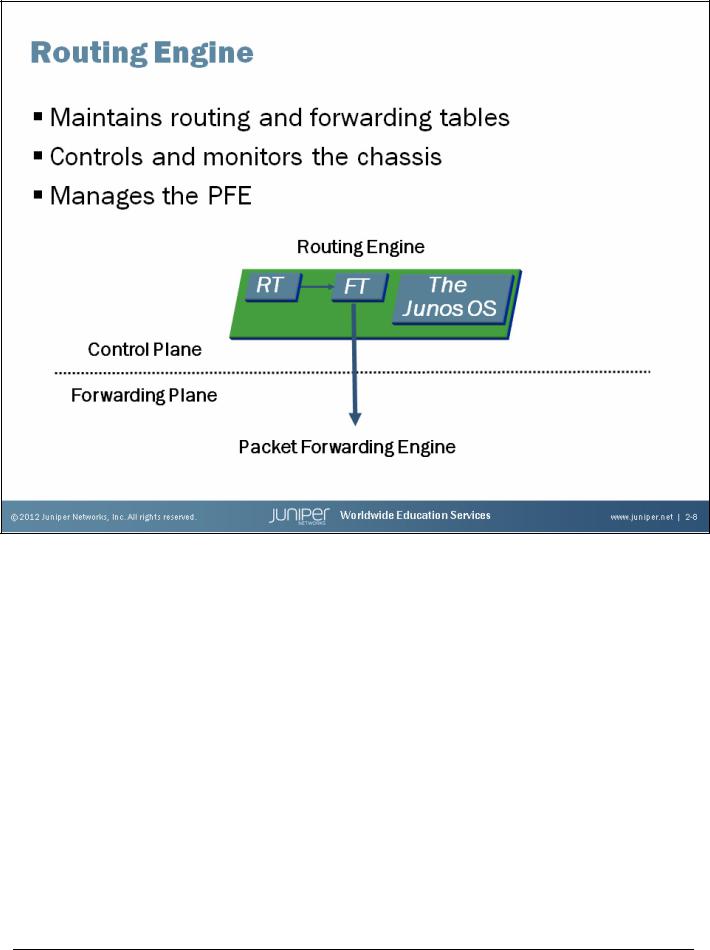
Introduction to the Junos Operating System
Maintains Routing Engine Intelligence
The RE handles all protocol processes in addition to other software processes that control the device’s interfaces, the chassis components, system management, and user access to the device. These software processes run on top of the Junos kernel, which interacts with the PFE. The software directs all protocol traffic from the network to the RE for the required processing.
Controls and Monitors Chassis
The RE provides the CLI in addition to the J-Web GUI. These user interfaces run on top of the Junos kernel and provide user access and control of the device. We discuss user interfaces in a subsequent chapter in this course.
Manages Packet Forwarding Engine
The RE controls the PFE by providing accurate, up-to-date Layer 2 and Layer 3 forwarding tables and by downloading microcode and managing software processes that reside in the PFE’s microcode. The RE receives hardware and environmental status messages from the PFE and acts upon them as appropriate.
Chapter 2–8 • Junos Operating System Fundamentals |
www.juniper.net |
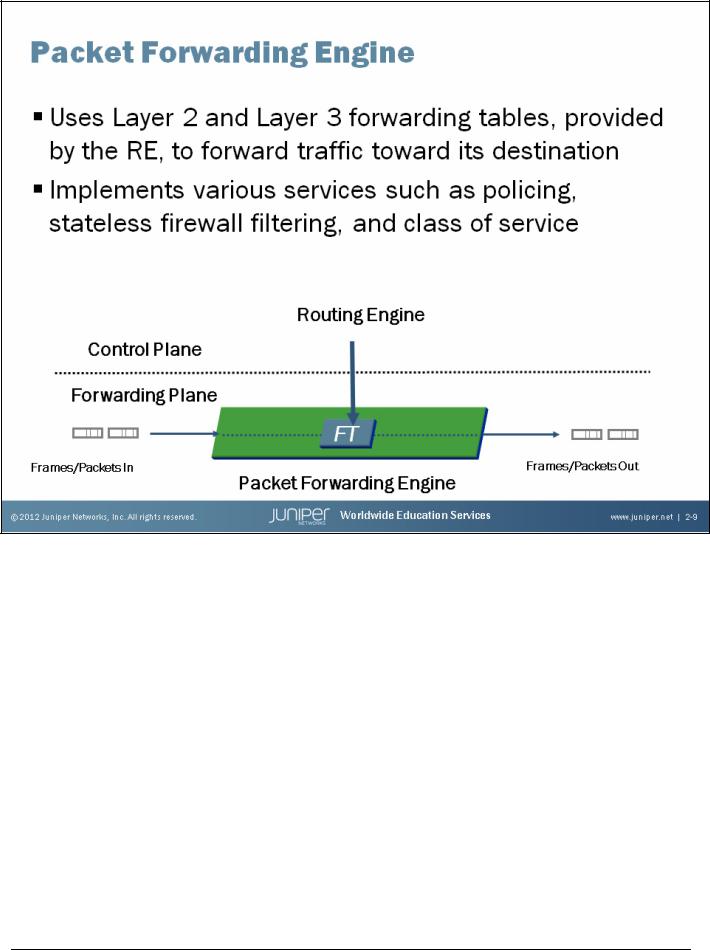
Introduction to the Junos Operating System
You might need to explain the term “policing”. The next section and a subsequent chapter provide additional details for policing or rate-limiting.
Forwards Traffic
The PFE is the central processing component of the forwarding plane. The PFE systematically forwards traffic based on its local copy of the forwarding table. The PFE’s forwarding table is a synchronized copy of the information created on and provided by the RE. Storing and using a local copy of the forwarding table allows the PFE to forward traffic more efficiently and eliminates the need to consult the RE each time a packet needs to be processed. Using this local copy of the forwarding table also allows platforms running the Junos OS to continue forwarding traffic during control plane instabilities. The PFE also maintains Layer 2 bridging information.
Implements Services
In addition to forwarding traffic, the PFE also implements a number of advanced services. Some examples of advanced services implemented through the PFE include policers that provide rate limiting, stateless firewall filters, and class of service (CoS). Other services are available through special interface cards that you can add to the PFE complex. We cover interfaces in a subsequent chapter.
www.juniper.net |
Junos Operating System Fundamentals • Chapter 2–9 |
